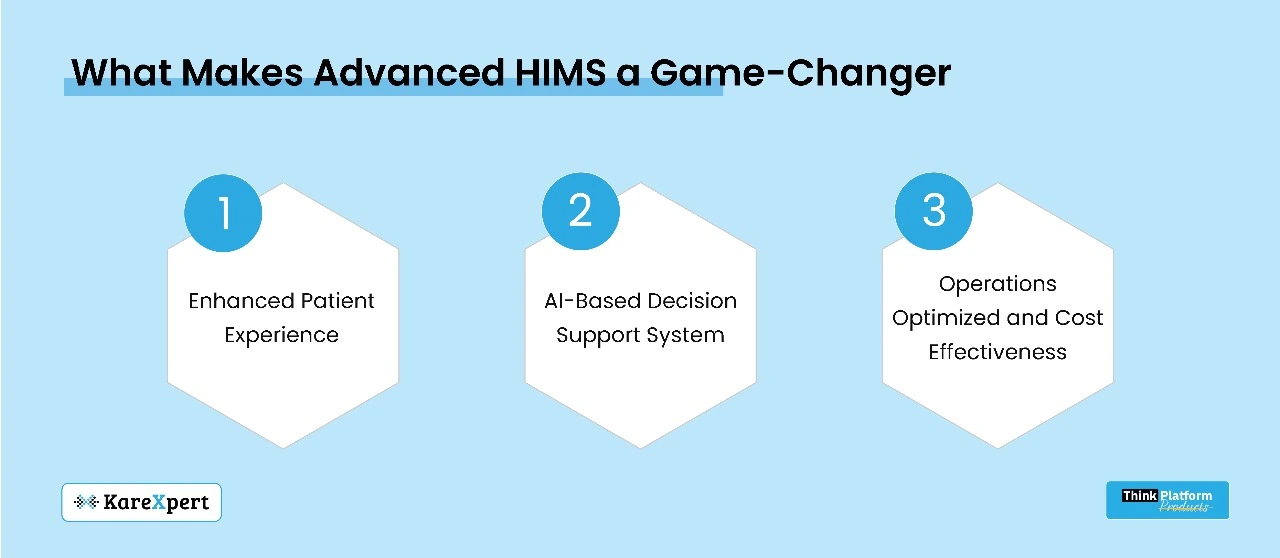Beyond the Basics: Why Advanced HIMS is No Longer a Luxury, But a Necessity

Changing Paradigm: Hospital Administration
For decades, traditional Hospital Information Management Systems (HIMS) have provided hospitals with the ability to manage patient records, billing, and administrative workflows. But the changing needs of contemporary healthcare have made basic HIMS solutions inadequate. As hospitals grow their services, implement value-based care models, and embrace cutting-edge medical technologies, a sophisticated HIMS has become a critical need rather than a luxury.
In this blog, let us discuss the challenges faced by healthcare organizations in operational, clinical, and patient experience and the need for moving from outdated systems to advanced HIMS solutions.
Modern Needs and Limitations of Existing HIMS
1. Traditional HIMS Solutions were fundamentally built for basic record-keeping. Their ability to integrate with modern healthcare technologies is limited, creating silos of data that hinder efficiency. They slow down the pace of decision-making and low-quality data are a burden for proactive care. This leads to increased errors and administrative burdens due to manual data entry.
2. Sluggish Interoperability with Emerging Technologies
Every modern hospital needs seamless integration with:
– Electronic Health Records (EHRs) for immediate access to patient data.
– Analytics powered by AI to aid precision medicine.
– IoT devices connected for real-time monitoring.
An elementary HIMS does not provide the requisite level of connectivity to enable these advances, limiting the ability of hospitals to scale digitalization.
3. Absence of Advanced Security and Compliance Features
Acts come and healthcare institutions are among the prime targets for cyberattacks and traditional HIMS often lack advanced security measures. Regulations such as HIPAA, GDPR, Ayushman Bharat Digital Mission (ABDM), and others call for advanced data security levels and access controls.
What Makes Advanced HIMS a Game-Changer

1. Enhanced Patient Experience
Patients now seek experiences that are personalized, seamless, and technology-enabled. Advanced HIMS enables:
– AI-Driven Automation for Rapid Appointment Scheduling.
– Features for telehealth integration in remote consultations.
– Patients and caregivers having real-time access to medical records.
These properties ensure better engagement, higher patient satisfaction, and improved retention rates.
2. AI-Based Decision Support System
AI-Powered HIMS amplifies its decision support capabilities with AI and machine learning-powered analytics:
– Early disease detection through predictive analytics.
– AI-guided diagnostic tools for minimizing human error.
– Automatic risk assessment to improve patient safety.
3. Operations Optimized and Cost Effectiveness
Hospitals are high-stakes environments where efficiency is key. Advanced HIMS automates and enhances a wide array of workflows:
– Automated billing and claims management eliminate financial inefficiencies.
– Automation in inventory and supply chain ensures critical resources are readily available.
– Optimizing staff scheduling with Artificial Intelligence.
Operational costs get reduced while service efficiency gets enhanced with these advancements.
Advanced HIMS in Action: Examples from the Field
1. Chains of Multi-Specialty Hospitals
An advanced HIMS was implemented by a leading hospital chain to:
– Integrate patient records in different locations.
– Allow departments to share data in real-time.
– Expand telemedicine capacity for rural outreach.
The result? A 30% speedup in clinical decision-making and improved satisfaction.
2. Smart Hospitals Leveraging AI
The AI-driven HIMS has caused significant advancements in patient monitoring, tailored treatment plans, and predictive healthcare management.
– AI-powered early sepsis detection lowered ICU admissions by 15%.
– The automated clinical workflows freed up 2 hours of each shift for doctors.
3. Public Healthcare Systems
Advanced HIMS benefits have helped government hospitals upgrade by digitizing patients’ history, tracking vaccine distribution, and automating compliance reporting, making health delivery more effective, thorough, and evident.
Overcoming Digital Transformation Barriers
While the benefits are evident, moving forward with an advanced HIMS comes with several barriers that must be overcome:
1. Resistance to Change – Staff are upskilled and trained to adjust to the new workflows. Fun to use interfaces take care of the switch.
2. Integration Challenges – Selecting modular, API-based solutions allows for integration with existing hospital infrastructure. Working with HIMS providers that offer support with your migration can also minimize risks of downtime and data loss.
3. Budget Constraints – Cloud-based HIMS platforms offer hospitals the convenience to adopt pay-as-you-grow models, thus rendering adoption feasible from a financial standpoint as well. Government and private sector funding programs can help in upgrading healthcare IT infrastructure.
Next Generation HIMS Future Trends
With the continuous advancement in technology, it is important for hospitals to keep pace. HIMS evolution with future advancements will include:
1. How Blockchain Improves Data Security – Making patient records tamper-proof and facilitating safe and clear information exchange between providers.
2. Personalized Treatment Plans Powered by AI – Utilizing AI in patients with precision medicine and personalized care. Using data insights to guide clinical decision-making in real time.
3. Internet of Things (IoT) Based Smart Hospital Management – IoT wearables for real-time patient vitals monitoring and predictive maintenance of hospital equipment.
Thus, the question itself becomes: Why is it time to upgrade? The era of thinking about advanced HIMS as a potential accessory is long gone. As the healthcare sector witnesses digital transformation at an unprecedented rate, hospitals not adopting AI-driven, state-of-the-art HIMS solutions fast enough are running the risk of becoming inefficient, failing to meet patients’ demands, facing financial penalties, etc.
Key Takeaways:
– Common HIMS are neither interoperable nor real-time or automated.
– Apart from having an advanced HIMS, it also improves patient care, helps in the growth of the organization by increasing the operational side, and sheds more light on the decision-making process.
– Integration and budget challenges faced by hospitals need to be resolved in order to compete.
To put it simply, you do not just invest in the next-generation HIMS just for the sake of technology; you invest in it to ensure that your hospital remains competent enough in the future to not only survive but thrive
